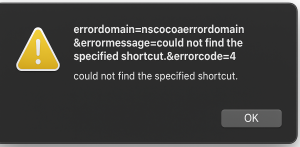Errordomain=nscocoaerrordomain&errormessage=could not find the specified shortcut.&errorcode=4

Freepik.com
Fixing errordomain=nscocoaerrordomain&errormessage=could not find the specified shortcut.&errorcode=4
If you’re seeing the error message:

errordomain=nscocoaerrordomain&errormessage=could not find the specified shortcut.&errorcode=4,
you are not alone. Many macOS and iOS users encounter this error when working with apps, shortcuts, or system preferences.
This error usually occurs when the system cannot locate a shortcut file, app command, or linked resource that the application is trying to access. It is associated with NSCocoaErrorDomain, which is Apple’s framework for handling Cocoa-related errors.
What Does NSCocoaErrorDomain Error Code 4 Mean?
The keyword errordomain=nscocoaerrordomain&errormessage=could not find the specified shortcut.&errorcode=4 specifically points to:
- Error Domain: NSCocoaErrorDomain (Apple Cocoa framework error handling).
- Error Code 4: Indicates “No such file or directory” or “Shortcut not found.”
- Error Message: “Could not find the specified shortcut.”
In simple terms, the app you are using is looking for a shortcut that no longer exists or was moved/deleted.
Common Reasons for This Error
- The shortcut or file was deleted or moved.
- The application cache is outdated.
- Permissions issues are preventing access to the shortcut.
- macOS/iOS updates broke an existing shortcut link.
- A corrupted preference file inside the app.
How to Fix errordomain=nscocoaerrordomain&errormessage=could not find the specified shortcut.&errorcode=4
Here are some working solutions:
- Recreate the Missing Shortcut
- Open the Shortcuts app (on Mac/iOS).
- Check if the shortcut exists. If not, recreate it.
- Check File or Directory Path
- If the error came from a file, make sure the file is in the right location.
- Move it back to the correct folder or re-link it.
- Reset App Permissions
- Go to System Settings > Privacy & Security > Files and Folders.
- Ensure the app has access to files/folders it needs.
- Clear Cache & Preferences
- Delete the app’s cache files from ~/Library/Caches/.
- Reset preferences by removing .plist files from ~/Library/Preferences/.
- Update macOS or iOS
- Many users reported the error disappeared after updating to the latest OS version.
- Reinstall the App
- If the error is app-specific, uninstall and reinstall the application.
Find Solution To Fix NSCocoaErrorDomain error 4 By Searching These Terms
- NSCocoaErrorDomain error 4 fix
- could not find the specified shortcut error
- NSCocoaErrorDomain could not find file
- macOS shortcut error code 4
- iOS shortcut not working error
How To Prevention Of The Error? errordomain=nscocoaerrordomain&errormessage=could not find the specified shortcut.&errorcode=4
errordomain=nscocoaerrordomain&errormessage=找不到指定的捷徑。&errorcode=4
Preventing the “Errordomain=NSCocoaErrorDomain&ErrorMessage=Could Not Find the Specified Shortcut.&ErrorCode=4” error involves taking steps to ensure that file paths and shortcuts are correctly managed and accessible. Here are some best practices to prevent this error:
- Verify File Paths: Always double-check file paths to ensure they are correct. This includes ensuring that directories and files exist where the application expects them.
- Maintain File Integrity: Avoid moving, renaming, or deleting files and directories that are critical for applications without updating the paths in the application configurations.
- Use Absolute Paths: Where possible, use absolute paths instead of relative paths to minimize the risk of incorrect path resolution.
- Check for Permissions: Ensure that the application and user have the necessary permissions to access the required files and directories. Use the chmod and chown commands to set appropriate permissions: (chmod 755 /path/to/your/file) > (chown yourusername:yourgroup /path/to/your/file)
- Regular Maintenance: Perform regular system maintenance, such as checking for and repairing disk errors using Disk Utility, and keeping the file system clean and organized.
- Backup and Restore: Maintain backups of critical files and directories. If a file is accidentally deleted or corrupted, you can restore it from the backup.
- Application Updates: Keep applications updated to the latest versions, as updates may fix bugs related to file management and path resolution.
- Use Aliases Instead of Shortcuts: On macOS, consider using aliases instead of traditional shortcuts. Aliases are more robust in tracking the original file or directory, even if it is moved or renamed.
- Test Environment: If you are developing an application, test it in a controlled environment to ensure all paths and shortcuts are correctly referenced and handled.
- Clear Cache Regularly: Some issues can be caused by cached data. Clearing the application’s cache periodically can prevent errors due to stale or corrupted cache files.
- Handle Errors Gracefully: In your application code, implement proper error handling to catch and manage errors related to missing files or incorrect paths. Provide meaningful error messages to help diagnose and fix the issue quickly.
Frequently Asked Questions (FAQs)
What is NSCocoaErrorDomain?
It is Apple’s standard error domain for Cocoa framework-related errors in macOS and iOS applications.
What does Error Code 4 mean?
Error Code 4 usually means “No such file or directory”, which explains why the system cannot find the specified shortcut.
Is this error harmful?
No, it’s not harmful. It simply means the system can’t find a shortcut or file. Fixing or recreating the shortcut will resolve it.
Can I ignore this error?
You can, but the app or shortcut may not function correctly until it is fixed.
Does reinstalling apps help?
Yes. Reinstalling or updating the app often fixes corrupted shortcut links.
Final Thoughts
Redress: errordomain=nscocoaerrordomain&errormessage=could not find the specified shortcut.&errorcode=4 may look complicated at first, but it simply means your system or app is unable to locate a shortcut or file it relies on. By following the fixes outlined above—such as recreating the missing shortcut, checking file paths, updating macOS/iOS, or resetting app permissions—you can resolve the problem quickly.
Since this is a common NSCocoaErrorDomain error, you don’t need to worry about data loss or system damage. It’s more of a missing link issue than a critical failure. If none of the solutions work, reinstalling the app or contacting Apple Support should be your last resort.
Keeping your system updated and organizing your shortcuts properly will help you avoid this error in the future.
❓ How do I permanently fix NSCocoaErrorDomain Error Code 4?
To permanently fix errordomain=nscocoaerrordomain&errormessage=could not find the specified shortcut.&errorcode=4, follow these steps:
- Recreate or relink the missing shortcut in the Shortcuts app.
- Check file paths to ensure the required file or directory exists.
- Grant app permissions in macOS/iOS Privacy & Security settings.
- Clear cache and preference files to remove corrupted data.
- Update macOS/iOS to the latest version for bug fixes.
- If nothing works, reinstall the affected app or contact Apple Support.
By keeping your system updated and avoiding accidental deletion of shortcuts or files, you can prevent this error from appearing again.






